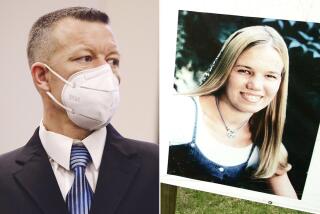Police Search for Bodies at Sect’s Compound : Japan: Authorities probe reports of corpses and of odd medical treatments conducted on followers.
- Share via
TOKYO — After finding materials that have led them to suspect a Japanese religious sect may have produced nerve gas and biological toxins, authorities on Tuesday turned to the grisly possibility that the group may have buried an undetermined number of bodies at its rural complex and conducted bizarre medical treatments on its members.
No bodies were immediately found at the complex of the Aum Supreme Truth cult, the group that has been linked to the deadly March 20 subway nerve gas attack that killed 10 and afflicted more than 5,000 commuters.
But hundreds of police swept the rural area, investigating reports by former followers of the secretive sect who have said they saw corpses being buried there.
“Aum Supreme Truth has nothing to do with religion, and it won’t be long before we start finding bodies,” a police officer, who asked not to be named, predicted to reporters on the scene at Kamikuishiki village, 65 miles southwest of Tokyo.
Attention was largely focused on a building that the sect called Satian No. 7, described as a maze-like complex housing a chemical laboratory that was hidden behind a wall. In front of the wall, sect members had placed an altar with a large image of Shiva, the Hindu god of destruction and renewal.
New evidence emerged, meanwhile, that at least some followers of the sect have suffered from strange medical or chemical treatments.
Seven cult members rescued from the building called Satian No. 10 were hospitalized, two of them showing highly unusual blood characteristics, the Yomiuri Shimbun reported. Satian, the Sanskrit word for truth , was used by the sect together with numbers to name each building in the sprawling complex.
*
Medical tests show one of the hospitalized sect followers has signs of apparent poisoning by sarin, the deadly nerve gas used in the attack in the Tokyo subways, and another has blood levels of a certain enzyme at 40 times what they should be, according to media reports here. The patient with the unusual enzyme readings reportedly told police: “Every day I was forced to take water mixed with white powder, and also I was supposed to get injections.”
This patient shows signs of memory loss and severe muscle stiffness, and is barely able to close his hand, the report said. “This is unimaginable in ordinary medical treatment,” a medical worker told the Yomiuri. “It’s just like live human experimentation.”
In the latest searches of the cult complex, police have confiscated large quantities of mind-affecting drugs, including some capable of producing hypnotic effects, Kyodo News Service reported today.
Meanwhile, the Public Security Investigation Agency, which normally monitors radicals of the left and right, has set up a special task force to investigate Aum Supreme Truth, Kyodo said.
The task force will consider possible application of the Subversive Activities Prevention Act against the sect because it “might have been attempting terrorism against the country,” the news service said. Since the law applies only when subversive activities have a political motive, the task force will study whether the sect’s doctrines are political, the report added. A group can be disbanded or its activities restricted under this law.
More details also emerged Tuesday about allegations that cult members were forced to pay huge sums for bizarre products and rituals. A leading newspaper here published a list of these, along with their prices--sums running into the thousands of dollars.
Police have confiscated several sophisticated chemical devices from the sect compound, including an advanced device for analyzing DNA and 160 metal drums of peptone, a solution used to cultivate bacteria.
The Mainichi Shimbun reported Tuesday that investigators had seized not only bacteria-production materials but also quantities of a germ, a kind of botulinus, that can produce a deadly toxin.
The cult may have had an interest in making biological weapons, but so far investigators have not found evidence that it actually produced any, police said.
Sect leaders have denied any involvement in the subway attack and have said the chemicals confiscated from the compound were for such uses as production of ceramics and plastics.
Police have asked authorities to investigate whether taxes can be imposed on Aum Supreme Truth’s business activities, Kyodo reported today.
Aum Supreme Truth was registered in 1989 as a religious organization and thus receives favorable tax treatment. Donations are exempt from tax, and reduced rates apply to profits from business activities.
Tax officials will examine how the sect handles donations and whether there is justification for searches at Aum-affiliated companies, Kyodo said.
Police found $7.9 million and 22 pounds of gold in a safe at a sect building in the city of Fujinomiya, about 80 miles southwest of Tokyo.
Some chemicals found at sect facilities in Kamikuishiki were purchased through cult-affiliated companies, and a tax investigation could provide a means to justify searches that might shed light on these purchases.
More to Read
Sign up for Essential California
The most important California stories and recommendations in your inbox every morning.
You may occasionally receive promotional content from the Los Angeles Times.












